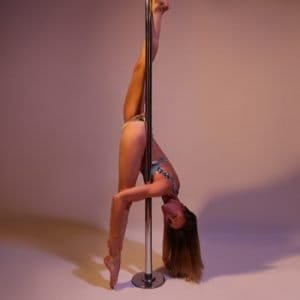Lots of you have asked recently about what you can do at home to complement your pole training and to try and boost your upper body strength. Here’s a whistlestop guide on training for pole, without the pole!
Strength & Flexibility Exercises

Any of the warmup work we do on the yoga mats can be used as conditioning in between lessons:
- Plank based exercises are great for the upper body and core. If possible, work alongside a mirror or try filming yourself to check your form – If you’re ploughing away with your bum sticking in the air or your hips sagging, you’re not going to get the benefit from the exercises and worse, might ended up injuring yourself, so make sure you check this first.
- It might sound mad, but if you live close to a park, why not utilise the monkey bars? Anything that allows you to pull down through the shoulders to lift your bodyweight and practice your shoulder engagement is gold!
- Handstands – these are good in that they utilise the opposing muscles to what we use for all our pole spins and lifts, as we are pushing rather than pulling with the shoulders. Got a clear wall in your house without obstructions? Why not try some kick ups? Or you can bunny hop more confidently knowing you can’t overshoot with the wall to stop you. (Only give this a go if you are already feeling semi-confident with them!)
- If you’re not confident in your arm strength to try handstanding at home, why not try the same with headstands/forearm stands? You can replicate the feeling of headstanding against the pole by resting against the wall. Like with pole, I would not advise headstanding or handstanding when alone in the house due to the potential of neck injury and not having anyone around to help in an emergency
- Dynamic stretches – think leg raises, downward dog leg walks, straddle sweeps etc
- Passive stretches – Think of the exercises we perform on the pole to cool down – you can replicate nearly all of these using a wall or doorframe and it’s actually a good idea to do so if you’ve worked hard and have gone away feeling particularly stiff. I like to have a short stretch before bed!
Foam Rollers and Spiky Massage Balls (Myofascial Release)

I love my foam roller! I use it as part of my before bed stretching routine and always feel as though my muscles are less ‘sticky’ as a result. I also use it if I can feel a knot forming. If you’re not sure where to start with using one, you might find this guide helpful. Spiky massage balls are particularly good for getting deep into the muscles and a good guide for getting going with these can be found here.
Online Resources
There are soo many youtube tutorials and free apps available offering short workout and stretching sequences. It’s good to check the reviews first to ensure the teacher knows their stuff and experiment a bit to see which formats you get on best with.
Cross Training

They say you can have too much of a good thing and I would certainly say this applies to pole. If you do nothing but pole, the demand will always be on the same muscle groups. This is where you will run into muscle imbalances and injuries (especially if you do not train both sides!).
By taking part in other activities you can help balance things out. For example:
- Yoga – more of a focus on breathing, balance and posture and provides a nice chance to stretch the tight muscles that have been working so hard for you during your pole sessions
- Swimming – a low impact, full body workout that can also help with cardio fitness
- Running – can help with your endurance and stamina and could be just what you need if you are performing a routine and know you need to keep going at high intensity for the duration of a song (showcase or competition anyone?!)
Of course, you might also want to utilise other activities to work the same muscle groups in a more targeted and balanced way:
- The gym – you can select your equipment and exercises the way you see fit and dependent on how you’re feeling that week. E.g. – you struggle to hold a plank and feel like your pec muscles are holding you back so decide to include chest presses in your workout. Or you feel you’ve been doing a huge amount of upper body work already at pole but you’re struggling with your seat or layback – the adductor machine might become your best friend!
Other Tips
- Make yourself a timetable that includes your pole lessons, any other classes/workouts and your home stretching and strengthening sessions. Ensure it’s realistic and that you aren’t overdoing things
- Don’t forget rest days!
What do you do at home to help with your pole progress? Let us know in the comments!



